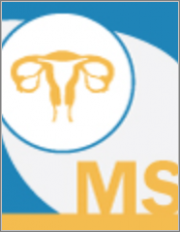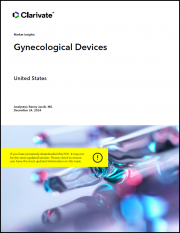
|
시장보고서
상품코드
1304146
미국의 부인과 기기 시장 : 규모, 동향(2023-2029년) : MedSuiteGynecological Devices Market Analysis, Size, Trends | United States | 2023-2029 | MedSuite |
||||||
2022년 미국의 부인과 기기 시장 규모는 약 13억 달러에 달했으며, 연간 약 300만 건의 부인과 수술이 그 원동력이 될 것입니다.
이 보고서는 미국의 부인과 기기(Gynecological Devices) 시장에 대해 조사했으며, 시장 개요와 함께 부문별 동향, 시장 진출기업 프로파일 등의 정보를 제공합니다.
목차
주요 요약
조사 방법
COVID-19가 미국 부인과 기기 시장에 미치는 영향
질병 개요
- 기본적 해부학
- 질병 치료 및 진단
- 환자 인구통계
제품 평가
- 서론
- 제품 포트폴리오
- 규제상 문제와 리콜
- 임상시험
미국의 부인과 기기 시장 개요
- 서론
- 시장 개요와 동향 분석
- 성장 촉진요인과 억제요인
- 시장 성장 촉진요인
- 시장 성장 억제요인
- 경쟁 시장 점유율 분석
- 인수합병(M&A)
- 기업 개요
- Boston Scientific
- Coloplast
- Cooper Surgical
- Hologic
- Laborie Medical
- Medtronic
- Merit Medical Systems
- Minerva Surgical
- Olympus
- Richard Wolf
- SWOT 분석
시술 건수
- 서론
- 난소암 발생률
- 골반 스크린
- 시술 건수 개요
보조생식기술 디바이스 시장
- 서론
- 시장 개요
- 시장 분석과 예측
- 성장 촉진요인과 억제요인
- 경쟁 시장 점유율 분석
세계의 자궁 내막 절제 시장
- 서론
- 시장 개요
- 시장 분석과 예측
- 성장 촉진요인과 억제요인
- 경쟁 시장 점유율 분석
자궁근종색전술 기기 시장
- 서론
- 시장 개요
- 시장 분석과 예측
- 성장 촉진요인과 억제요인
- 경쟁 시장 점유율 분석
부인과 내시경 시장
- 서론
- 시장 개요
- 시장 분석과 예측
- 성장 촉진요인과 억제요인
- 경쟁 시장 점유율 분석
부인과 절제 전극 시장
- 서론
- 시장 개요
- 시장 분석과 예측
- 성장 촉진요인과 억제요인
- 경쟁 시장 점유율 분석
세절 제거기(morcellators) 시장
- 서론
- 시장 분석과 예측
- 성장 촉진요인과 억제요인
- 경쟁 시장 점유율 분석
골반저 전기 자극 장비 시장
- 서론
- 시장 개요
- 시장 분석과 예측
- 성장 촉진요인과 억제요인
- 경쟁 시장 점유율 분석
유체 관리 기기 시장
- 서론
- 시장 개요
- 시장 분석과 예측
- 성장 촉진요인과 억제요인
- 경쟁 시장 점유율 분석
골반 장기 탈출증 수복 장비 시장
- 서론
- 시장 개요
- 시장 분석과 예측
- 성장 촉진요인과 억제요인
- 경쟁 시장 점유율 분석
HSG 카테터 시장
- 서론
- 시장 분석과 예측
- 성장 촉진요인과 억제요인
- 경쟁 시장 점유율 분석
부록 : 자궁 매니퓰레이터 시장
- 서론
- 시장 분석과 예측
- 성장 촉진요인과 억제요인
- 경쟁 시장 점유율 분석
약어
LSH 23.07.14In 2022, the gynecological devices market in the United States reached a value of approximately $1.3 billion, driven by nearly 3 million gynecological procedures performed annually. Our extensive research in the medical device market encompassed over 70 gynecological device companies across the United States. Through our comprehensive methodology, we analyzed market sizes, unit sales, company market shares, and developed accurate forecasts.
The complete report suite on the U.S. market for gynecological devices covers a wide range of products, including assisted reproduction technology devices, global endometrial ablation, uterine fibroid embolization devices, gynecological endoscopes, gynecological resection electrodes, morcellators, pelvic floor electrical stimulation devices, fluid management devices, pelvic organ prolapse repair devices, and hysterosalpingography (HSG) catheters.
DATA TYPES INCLUDED:
- Unit Sales, Average Selling Prices, Market Value & Growth Trends
- Gynecological Procedure Volumes
- Forecasts Until 2029, and Historical Data to 2019
- Market Drivers & Limiters for Each Gynecological Device market
- Competitive Analysis with Market Shares for Each Segment
- Recent Mergers & Acquisitions
- Disease Overviews and Demographic Information
- Company Profiles, Product Portfolios and SWOT for Top Competitors
U.S. GYNECOLOGICAL DEVICES MARKET INSIGHTS
As companies vie for market share, pricing strategies in the gynecological devices industry become crucial. This has led to a downward trend in average selling prices (ASPs) across market segments. Lower prices may entice purchasers to explore alternative solutions, prompting providers of alternative gynecological devices to further reduce their prices in a cross-category price competition. The formation of purchasing groups by clinics has bolstered buyers' leverage, compelling sellers to offer competitive prices to secure broader market access. The competitive landscape puts pressure on sellers to ensure their pricing aligns with buyer expectations and demands.
One significant trend in the U.S. market for gynecological devices is the avoidance, when possible, of hysterectomies as a treatment option. Fibroids and endometriosis affect a significant proportion of women in the United States, with 20-25% of reproductive-age women and 11% of women between 15 and 44 being affected, according to the U.S. National Institutes of Health (NIH). To address these conditions, physicians are increasingly turning to minimally invasive treatments such as hysteroscopic surgeries, uterine artery embolization, and endometrial ablation, when the condition permits. These alternative procedures offer less invasiveness, shorter recovery periods, and have become preferred options for patients seeking to avoid the need for hysterectomy.
U.S. GYNECOLOGICAL DEVICES MARKET SHARE INSIGHTS
Hologic, Medtronic, Cooper Surgical, and Minerva Surgical emerged as the dominant players in the U.S. gynecological device market, collectively capturing more than 50% of the total market share.
Hologic dominated the U.S. gynecological device market with its strong presence in various segments, including global endometrial ablation, hysteroscopic morcellators, endoscopes, and fluid management devices.
Medtronic secured the second position, competing in the morcellator and fluid management device markets. Their TruClear™ Hysteroscopic morcellator contributed significantly to their market share in the morcellator device segment.
Minerva Surgical held the fourth position, participating in the global endometrial ablation, gynecological endoscope, morcellator, and fluid management markets. Their acquisition of the intrauterine portfolio from Boston Scientific in 2020 further strengthened their position.
Cooper Surgical emerged as the leading competitor in the assisted reproduction technology device, gynecological endoscope, and HSG catheter segments, contributing to their third-leading market share in the U.S. gynecological device market.
SEGMENTS COVERED:
- Assisted reproduction technology devices
- Global endometrial ablation
- Uterine fibroid embolization devices
- Gynecological endoscopes
- Gynecological resection electrodes
- Morcellator devices
- Pelvic floor electrical stimulation devices
- Fluid management devices
- Pelvic organ prolapse repair devices
- Hysterosalpingography (HSG) catheters
TABLE OF CONTENT
- Table of Contents
- List of Figures
- List of Charts
Executive summary
- U.S. Gynecological Device Market Overview
- Competitive Analysis
- Market Trends
- Market Developments
- Procedure Numbers
- Procedure Codes Investigated
- Markets Included
- Key Report Updates
- Version History
Research methodology
- Step 1: Project Initiation & Team Selection
- Step 2: Prepare Data Systems and Perform Secondary Research
- Step 3: Preparation for Interviews & Questionnaire Design
- Step 4: Performing Primary Research
- Step 5: Research Analysis: Establishing Baseline Estimates
- Step 6: Market Forecast and Analysis
- Step 7: Identify Strategic Opportunities
- Step 8: Final Review and Market Release
- Step 9: Customer Feedback and Market Monitoring
Impact of covid-19 on the U.S. Gynecological device Market
- 2.1. Introduction
- 2.2. Analysis By Market Segment
- 2.2.1. Best Case Scenario
- 2.2.2. Base Case Scenario
- 2.2.3. Worst Case Scenario
Disease Overview
- 3.1. Basic Anatomy
- 3.2. Disease Treatment and Diagnostic
- 3.2.1. Introduction
- 3.2.2. General Diagnostics
- 3.2.3. Assisted Reproduction Technologies (ART)
- 3.2.3.1. ART Costs
- 3.2.4. Abnormal Uterine Bleeding
- 3.2.5. Gynecologic Cancer and Tumors in Reproductive System
- 3.2.6. Female Sterilization
- 3.2.7. Urinary Incontinence
- 3.2.8. Pelvic Organ Prolapse
- 3.3. Patient Demographics
- 3.3.1. Assisted Reproduction Technologies (ART)
- 3.3.2. Abnormal Uterine Bleeding
- 3.3.3. Gynecologic Cancer and Tumors in Reproductive System
- 3.3.4. Pelvic Organ Prolapse
- 3.3.5. Endometriosis
- 3.3.6. Polycystic ovary syndrome
- 3.3.7. Female Sterilization
Product Assessment
- 4.1. Introduction
- 4.2. Product Portfolios
- 4.2.1. Assisted Reproduction Technology Device
- 4.2.2. Global Endometrial Ablation Market
- 4.2.3. Uterine Fibroid Embolization Device
- 4.2.4. Gynecological Endoscopes
- 4.2.5. Gynecological Resection Electrode
- 4.2.6. Gynecological Morcellators
- 4.2.7. Pelvic Floor Electrical Stimulation Device
- 4.2.8. Fluid Management Device
- 4.2.9. Pelvic Organ Prolapse Repair Device
- 4.2.10. HSG Catheter
- 4.2.11. Uterine Manipulators
- 4.3. Regulatory Issues and Recalls
- 4.3.1. Assisted Reproduction Technology Device Market
- 4.3.2. Gynecological Endoscope Market
- 4.3.3. Gynecological Resection Electrode Market
- 4.3.4. Morcellator Market
- 4.3.5. Fluid Management Device Market
- 4.3.6. Pelvic Organ Prolapse Repair Device Market
- 4.3.7. HSG Catheter Market
- 4.3.8. Uterine Manipulator Market
- 4.4. Clinical Trials
- 4.4.1. Assisted Reproduction Technology Device
- 4.4.2. Global Endometrial Ablation
- 4.4.3. Uterine Fibroid Embolization Device
- 4.4.4. Gynecological Endoscopes
- 4.4.5. Gynecological Morcellators
- 4.4.6. Pelvic Floor Electrical Stimulation Device
- 4.4.7. Pelvic Organ Prolapse Repair Device
- 4.4.8. Uterine Manipulators
U.S. Gynecological Device Market Overview
- 5.1. Introduction
- 5.2. Market Overview and Trend Analysis
- 5.3. Drivers and Limiters
- 5.3.1. Market Drivers
- 5.3.2. Market Limiters
- 5.4. Competitive Market Share Analysis
- 5.5. Mergers and Acquisitions
- 5.6. Company Profiles
- 5.6.1. Boston Scientific
- 5.6.2. Coloplast
- 5.6.3. Cooper Surgical
- 5.6.4. Hologic
- 5.6.5. Laborie Medical
- 5.6.6. Medtronic
- 5.6.7. Merit Medical Systems
- 5.6.8. Minerva Surgical
- 5.6.9. Olympus
- 5.6.10. Richard Wolf
- 5.7. SWOT Analysis
- 5.7.1. Boston Scientific
- 5.7.2. Coloplast
- 5.7.3. Cooper Surgical
- 5.7.4. Hologic
- 5.7.5. Laborie Medical
- 5.7.6. Medtronic
- 5.7.7. Merit Medical Systems
- 5.7.8. Minerva Surgical
- 5.7.9. Olympus
- 5.7.10. Richard Wolf
Procedure Numbers
- 6.1. Introduction
- 6.1.1. Ovarian Cancer Incidence
- 6.1.2. Pelvic Screens
- 6.2. Procedures Number Overview
- 6.2.1. Fallopian Tube Procedures
- 6.2.2. Assisted Reproduction Technology Procedures by Type
- 6.2.3. Cervical Repair and Biopsy Procedures
- 6.2.4. Global Endometrial Ablation Procedures
- 6.2.4.1. Thermal Ablation Procedures
- 6.2.4.2. Hydrothermal Ablation Procedures
- 6.2.4.3. Radiofrequency Ablation Procedures
- 6.2.4.4. Cryoablation Procedures
- 6.2.5. Uterine Fibroid Embolization Procedures by Type
- 6.2.6. Gynecological Endoscope Procedures
- 6.2.7. Morcellation Procedures
- 6.2.8. Vaginal Procedures
- 6.2.9. Pelvic Organ Prolapse Procedures by Type
- 6.2.10. HSG Catheter Procedures by Type
- 6.2.11. Myomectomy Procedures
- 6.2.12. Hysterectomy Procedures
- 6.2.12.1. Hysterectomy Procedures by Type
- 6.2.12.1. Hysterectomy Procedures by Approach
Assisted Reproduction Technology Device Market
- 7.1. Introduction
- 7.1.1. Media
- 7.1.2. Vitrification
- 7.2. Market Overview
- 7.3. Market Analysis and Forecast
- 7.3.1. Oocyte Retrieval Needle Market
- 7.3.2. Micropipette Market
- 7.3.2.1. Flexible Pipette Market
- 7.3.2.2. ICSI Pipette Market
- 7.3.3. Embryo Transfer Catheter Market
- 7.3.4. Reproduction Media Market
- 7.3.4.1. Culture Media Market
- 7.3.4.2. Sperm Preparation Media Market
- 7.3.4.3. Manipulation Media Market
- 7.3.4.4. Freeze/Thaw Media Market
- 7.4. Drivers and Limiters
- 7.4.1. Market Drivers
- 7.4.2. Market Limiters
- 7.5. Competitive Market Share Analysis
Global Endometrial Ablation Market
- 8.1. Introduction
- 8.1.1. Hydrothermal Ablation
- 8.1.2. Radiofrequency Ablation
- 8.1.3. Cryoablation
- 8.1.4. Roller-Ball Ablation
- 8.2. Market Overview
- 8.3. Market Analysis and Forecast
- 8.3.1. Total Global Endometrial Ablation Market
- 8.3.2. Thermal Ablation Device Market
- 8.3.3. Hydrothermal Ablation Device Market
- 8.3.4. Radiofrequency Ablation Device Market
- 8.3.5. Cryoablation Device Market
- 8.4. Drivers and Limiters
- 8.4.1. Market Drivers
- 8.4.2. Market Limiters
- 8.5. Competitive Market Share Analysis
Uterine Fibroid Embolization Device Market
- 9.1. Introduction
- 9.1.1. Microspheres
- 9.1.2. Polyvinyl Alcohol Particles
- 9.1.3. Drug-Eluting Particles
- 9.2. Market Overview
- 9.3. Market Analysis and Forecast
- 9.3.1. Microsphere Market
- 9.3.2. PVA Particle Market
- 9.4. Drivers and Limiters
- 9.4.1. Market Drivers
- 9.4.2. Market Limiters
- 9.5. Competitive Market Share Analysis
Gynecological Endoscope Market
- 10.1. Introduction
- 10.1.1. Hysteroscopes
- 10.1.2. Colposcopes
- 10.1.3. Resectoscopes
- 10.2. Market Overview
- 10.3. Market Analysis and Forecast
- 10.3.1. Hysteroscope Market
- 10.3.1.1. Reusable Hysteroscope Market
- 10.3.1.2. Reusable Rigid Hysteroscope Market
- 10.3.1.3. Reusable Flexible Hysteroscope Market
- 10.3.1.3.1. Video Flexible Hysteroscope Market
- 10.3.1.3.2. Fiber Flexible Hysteroscope Market
- 10.3.1.4. Disposable Hysteroscope Market
- 10.3.2. Colposcope Market
- 10.3.2.1. Video Colposcope Market
- 10.3.2.2. Non-Video Colposcope Market
- 10.3.3. Resectoscope Market
- 10.3.1. Hysteroscope Market
- 10.4. Drivers and Limiters
- 10.4.1. Market Drivers
- 10.4.2. Market Limiters
- 10.5. Competitive Market Share Analysis
Gynecological Resection Electrode Market
- 11.1. Introduction
- 11.2. Market Overview
- 11.3. Market Analysis and Forecast
- 11.3.1. Monopolar Loop Electrode Market
- 11.3.2. Bipolar Loop Electrode Market
- 11.4. Drivers and Limiters
- 11.4.1. Market Drivers
- 11.4.2. Market Limiters
- 11.5. Competitive Market Share Analysis
Morcellator Market
- 12.1. Introduction
- 12.2. Market Analysis and Forecast
- 12.2.1. Laparoscopic Morcellator Market
- 12.2.2. Hysteroscopic Morcellator Market
- 12.3. Drivers and Limiters
- 12.3.1. Market Drivers
- 12.3.2. Market Limiters
- 12.4. Competitive Market Share Analysis
Pelvic Floor Electrical Stimulation Device Market
- 13.1. Introduction
- 13.2. Market Overview
- 13.3. Market Analysis and Forecast
- 13.3.1. Home-Based PFES Device Market
- 13.3.2. Office-Based PFES Device Market
- 13.4. Drivers and Limiters
- 13.4.1. Market Drivers
- 13.4.2. Market Limiters
- 13.5. Competitive Market Share Analysis
Fluid Management Device MarkeT
- 14.1. Introduction
- 14.2. Market Overview
- 14.3. Market Analysis and Forecast
- 14.3.1. Fluid Management Equipment Market
- 14.3.2. Fluid Management Tubing Market
- 14.4. Drivers and Limiters
- 14.4.1. Market Drivers
- 14.4.2. Market Limiters
- 14.5. Competitive Market Share Analysis
Pelvic Organ Prolapse Repair Device Market
- 15.1. Introduction
- 15.2. Market Overview
- 15.3. Market Analysis and Forecast
- 15.3.1. Transvaginal Mesh Market
- 15.3.2. Sacrocolpopexy Mesh Market
- 15.4. Drivers and Limiters
- 15.4.1. Market Drivers
- 15.4.2. Market Limiters
- 15.5. Competitive Market Share Analysis
HSG Catheter Market
- 16.1. Introduction
- 16.2. Market Analysis and Forecast
- 16.3. Drivers and Limiters
- 16.3.1. Market Drivers
- 16.3.2. Market Limiters
- 16.4. Competitive Market Share Analysis
Appendix: Uterine Manipulator market
- 17.1. Introduction
- 17.2. Market Analysis and Forecast
- 17.3. Drivers and Limiters
- 17.3.1. Market Drivers
- 17.3.2. Market Limiters
- 17.4. Competitive Market Share Analysis
Abbreviations
(주말 및 공휴일 제외)


















